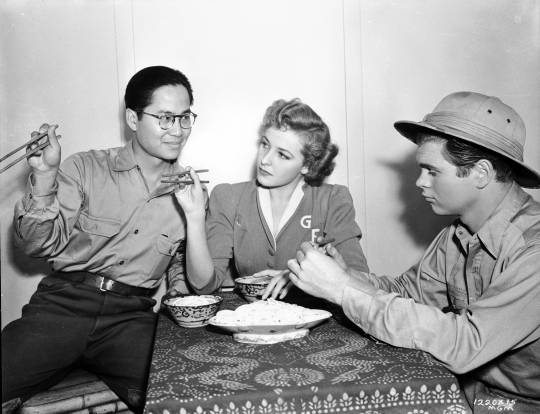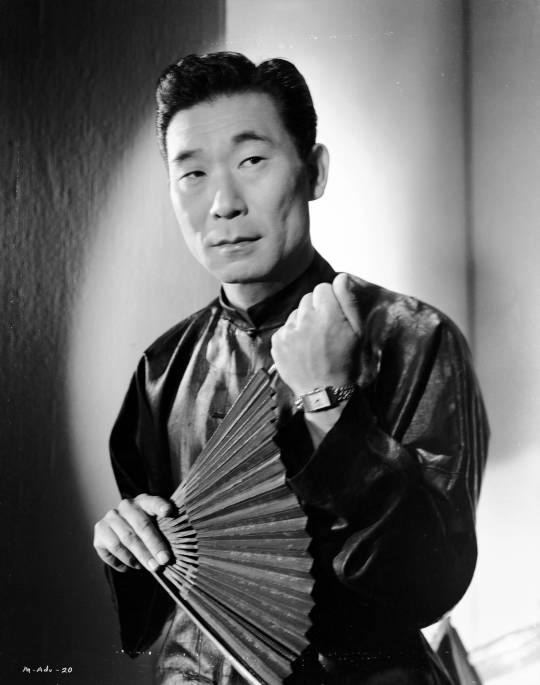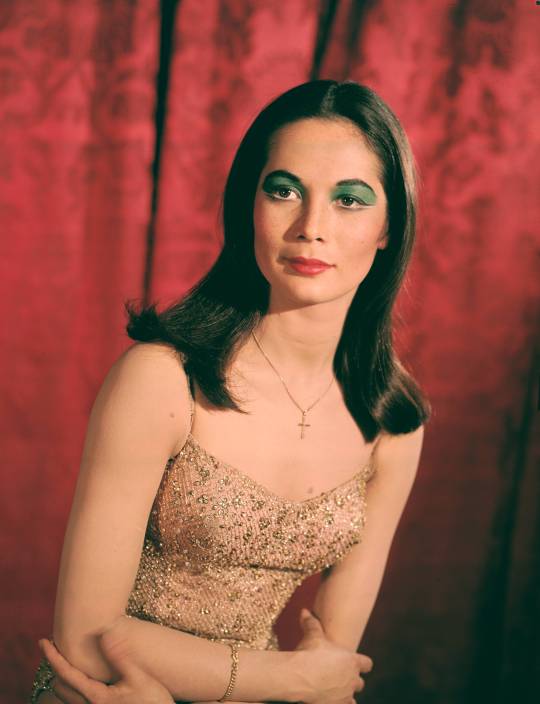#Miyoshi Umek
Explore tagged Tumblr posts
Text
“It’s still hard:” Asian Americans Paving the Way in Hollywood By Jessica Pickens

The 2018 film CRAZY RICH ASIANS was a success in many areas. Based on the best-selling novel by Kevin Kwan, the film became the highest-grossing romantic comedy in 10 years. An August 2018 article in Time Magazine noted that the film would “change Hollywood.” CRAZY RICH ASIANS was the first film since THE JOY LUCK CLUB (’93) to have an all-Asian American cast or an Asian American lead role. Nearly 60 years before, the all Asian American cast of FLOWER DRUM SONG (‘61) also hoped they were changing the way Asians were cast in Hollywood.
Since the silent era of films, Asian American actors have struggled to find quality roles and respect in Hollywood. Some, actors like Sessue Hayakawa and Anna May Wong, were frequently cast as vamps or villains — which in return put them in poor favor with Japanese and Chinese communities of their time. Miscegenation laws kept Asian American actors from having a romantic leading role with a white actor. In turn, Asians lost roles to white actors in yellowface, from Austrian actress Luise Rainer in THE GOOD EARTH (’37) to English actor Alec Guinness in A MAJORITY OF ONE (’61).
These actors helped fight and pave the way for the success of CRAZY RICH ASIANS:
Sessue Hayakawa

Today, actor Sessue Hayakawa is best recognized for his roles in THE BRIDGE ON THE RIVER KWAI (’57) and as the pirate in Walt Disney’s SWISS FAMILY ROBINSON (’60). But from 1915 to the early 1920s, Japan-born Hayakawa was one of the top silver screen idols of the silent era in the United States and Europe. He was as famous and recognizable as Charlie Chaplin or Douglas Fairbanks, according to his biographer Daisuke Miyao in the book Sessue Hayakawa: Silent Cinema and Transnational Stardom.
Fame followed Hayakawa after playing the lead in Cecil B. DeMille’s THE CHEAT (’15), in which he gives a financial loan to a wealthy woman (Fannie Ward). When she tries to back out of their bargain, he won’t take money as payment, but sexual favors. His character also brands Ward to signify that he owns her. THE CHEAT brought Hayakawa success, but it also brought typecasting. His resulting characters were usually dangerous, forbidden lovers or sexy villains. Hayakawa was criticized by the Japanese-American community for his roles. The Los Angeles-based Japanese American newspaper Rafu Shimpo said THE CHEAT “distorted the truth of Japanese people” depicting them as dangerously evil and would cause anti-Japanese movements.
Hayakawa eventually grew tired of the stereotypical roles he was cast in. In 1922, Hayakawa went to Europe where he performed in England and France. He stayed in Europe until after World War II and returned to Hollywood in 1949. Hayakawa was recognized for his role in THE BRIDGE ON THE RIVER KWAI with an Academy Award nomination for Best Actor in a Supporting Role.
Anna May Wong

She was rejected by China because she was “too American” and rejected in Hollywood because she was “too Chinese.” But Chinese American actress Anna May Wong achieved international fame by the mid-1920s, though she struggled with being stereotyped. Often cast as a vamp, sexual figure, slave or prostitute, the Chinese government said she played roles that demeaned China, and Graham Russell Hodges’ Anna May Wong: From Laundryman's Daughter to Hollywood Legend recalls how the Chinese media and government resented “having their womanhood so represented.”
When Wong campaigned for roles that could potentially change her image, like O-Lan in THE GOOD EARTH, she lost out to a white actor playing yellowface. In fact, the Chinese government worked against Wong being cast in THE GOOD EARTH. Hodges states how General Tu, MGM’s Chinese government advisor, told MGM that her reputation was bad in China and whenever she appeared in a film, newspapers printed that “Anna May loses face in China again.”
When white actor Paul Muni was cast as the male lead of THE GOOD EARTH, Wong knew she had missed her opportunity because of miscegenation laws. Wong supported China during World War II through the Red Cross, USO and China Relief efforts. She also wrote articles in China’s support and created a cookbook of traditional Chinese dishes. On the first anniversary of the Pearl Harbor attacks, she was sworn in as an air raid warden, according to Hodge’s book.
In 1943, the First Lady of the Republic of China, Madame Chiang Kai-shek, visited Hollywood. She gave a speech at the Hollywood Bowl and a luncheon was held. Madame Chiang Kai-shek was flanked by actresses like Marlene Dietrich and Loretta Young, but noticeably not Wong. Madame Chiang had specifically requested for Wong to be excluded from the events. Anna May Wong continued to act sporadically and died just before she was to co-star in the all Asian American cast of THE FLOWER DRUM SONG.
Keye Luke

Chinese actor Keye Luke started in films in the 1930s, usually playing a mild-mannered, polite and intelligent young adult Asian male. Often, Luke played young physicians, like in THE PAINTED VEIL (’34), MAD LOVE (’35) and the Dr. Kildare and Dr. Gillespie film series. Luke became best known for his role in the 1930s as Lee Chan, the No. 1 son of detective Charlie Chan, who was played by white actor Warner Oland. The film series has since been criticized for perpetuating Asian stereotypes and having a white actor in the lead role, but Luke defended the films.
“How can they be criticized when the character was a hero,” Luke said in a 1986 Los Angeles Times interview. “People respected him. Police departments consulted with him and called on him to help them.” However, despite this, Luke and other Asians faced racism in Hollywood. Luke said in the 1930s that Los Angeles was “segregated, but not formally.” He was only hired when they needed a “Chinaman.”
“One never saw blacks on Wilshire Boulevard. Parts of the city I avoided–all white areas like Beverly Hills. Even after working with somebody like a big Caucasian actor, I’d be ignored if we met on the street. Asians were invisible, you see. We knew our place: One step back. That’s why the Charlie Chan films were so important. They deflated a lot of the current racial myths. But even the Chan films had rules. Charlie never touched a white woman except as a handshake. I’d never have a white girlfriend, not that I wanted one in pictures,” Luke said in an interview published in Conversations with Classic Film Stars: Interviews from Hollywood's Golden Era by James Bawden and Ron Miller.
After World War II, Luke found roles were harder to find, and many of his roles were uncredited. By the 1960s, more Asian actors were on the screen. In his interview with Miller, Luke joked that before the 1960s he and Korean actor Philip Ahn “divided the work.”
Philip Ahn

Philip Ahn was a Korean American actor who only played a Korean character once on film. In Hye Seung Chung’s Hollywood Asian: Philip Ahn and the Politics of Cross-Ethnic Performance, he details how before World War II, Ahn was promoted as a Chinese actor and often nicknamed the “Oriental Clark Gable.” During World War II, however, Hollywood shifted its publicity and focused on Ahn’s Korean ancestry. The publicity articles discussed Ahn’s father, Ahn Changho, who was an activist against the Japanese government. Ahn was also promoted as “the man we love to hate” and the “leering yellow monster.”
During the war, Ahn was frequently cast as a Japanese soldier in the 1940s, something he later said that he didn’t mind, as he felt he was contributing to his late father's legacy. Despite these characters not reflecting Ahn’s personality, Chung recalls how Ahn received hate mail from audiences who confused his onscreen characters for real life. In the 1953 Korean War film BATTLE CIRCUS, Ahn and his brother Ralph both played North Korean prisoners. Ahn said while he played many nationalities, this was the only time he played a Korean character, according to his 1978 The New York Times obituary.
Miyoshi Umeki

Japan-born Miyoshi Umeki was the first Asian to win an Academy Award for a performance. Umeki won Best Supporting Actress for her first Hollywood film, SAYONARA (’57). Though Umeki was the first Asian to win an Academy Award, this “first” isn’t often discussed. Despite the accolade, Umeki was still stereotyped in Hollywood. Her characters were generally demure, humble, delicate and subservient. Umeki’s characters spoke in broken English with a sweet smile.
Her son Michael Hood later asked her why she agreed to play these characters. “Her answer was very simple: ‘I didn’t like doing it, but when someone pays you to do a job, you do the job, and you do your best,’” Hood said in a 2018 Entertainment Weekly article. Umeki later threw away her Academy Award statue, according to Hood. As of 2020, Umeki is the only Asian female to win an Academy Award.
Nancy Kwan

Hong Kong-born actress Nancy Kwan burst on to the film scene in 1960. She was cast as the lead in THE WORLD OF SUZIE WONG (’60) alongside one of Hollywood’s top actors, William Holden. Kwan was then cast in the all -Asian American cast of the Rodgers and Hammerstein film version of FLOWER DRUM SONG. With a strong start in films, a successful Hollywood career seemed likely for Kwan, but the roles weren’t there. William Holden told her, “You can do a big film and be very successful but in order to sustain a career, you have to have roles written for you,” Kwan shared in a 2018 NBC interview. Kwan was more successful than her predecessors, however, as Asians were starting to be cast rather than white actors in yellowface. Kwan was also cast in roles where she had white romantic leading men, like HONEYMOON HOTEL (’64) and THE WILD AFFAIR (’65). But Hollywood still didn’t know what to do with Kwan. She was cast in “exotic” roles like in the Walt Disney film LT. ROBIN CRUSOE, U.S.N. (’66) as an island girl. Kwan was offered a role in the film THE JOY LUCK CLUB, but she revealed in a 2018 interview at the TCM Classic Film Festival that she declined it because of a line criticizing SUZIE WONG. While she mentioned in a 1990 Los Angeles Times interview that “There are now many, many Asian actresses — but not many roles,” 18 years later she noted that the film industry had changed, but not enough. “There are more leading roles and not just small roles, but it’s still hard.”
#Asian American#Asians in Hollywood#Sessue Hayakawa#Anna May Wong#Philip Ahn#Miyoshi Umek#Keye Luke#Nancy Kwan#TCM#Turner Classic Movies#Jessica Pickens#classic hollywood
715 notes
·
View notes